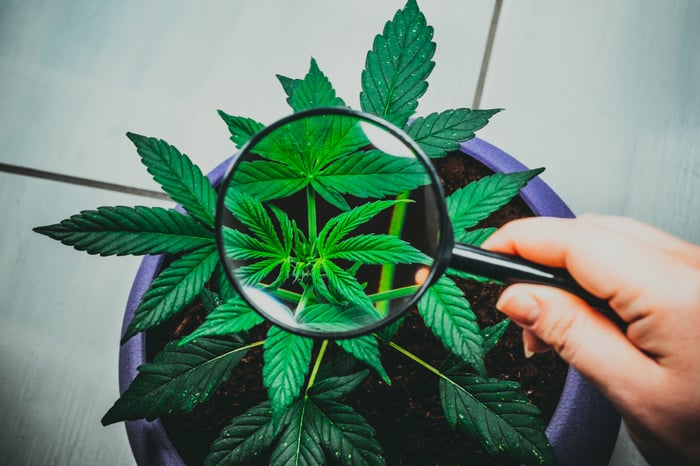According to a newly released report from the duo of Arcview Market Research and BDS Analytics titled "State of the Legal Cannabis Markets," global cannabis sales could grow in excess of 24% per year through 2024. After registering $10.9 billion in legal sales in 2018, Arcview and BDS have forecast more than $40 billion in worldwide weed sales in licensed stores by 2024. That makes cannabis one of the fastest-growing industries on the planet.
But as investors, we also know that not every company in a fast-growing industry is necessarily going to live up to expectations. With supply chain issues abounding throughout North America, quite a few popular pot stocks have been major disappointments on the earnings front. The following three marijuana stocks have echoed that disappointment by delivering some of the worst gross margins in the entire industry.

Image source: Getty Images.
Canopy Growth
Pardon the pun, but expectations were high heading into Canopy Growth's (CGC 20.65%) fourth-quarter earnings report that it would, like Aurora Cannabis, buck the recent weakness in Canadian weed sales and deliver modestly higher sequential quarterly revenue. Although this proved to be the case, the only reason Canopy's sales rose was the result of much higher ancillary revenue via acquisitions. Both the company's recreational and medical marijuana revenue declined on a sequential quarterly basis. That led Canopy Growth to report a ghastly gross margin, before fair-value adjustments on biological assets, of 15.9%.
On one hand, a large loss and diminished gross margin was sort of the expectation from Canopy's fourth-quarter report. Management has made no secret that it's investing heavily in infrastructure domestically and abroad (especially in the United States) to reap the long-term rewards of cannabis, hemp, and derivative-product expansion. It's not cheap to lay the groundwork for this infrastructure throughout North America, which is liable to keep Canopy Growth in the red through fiscal 2020.
But on the other hand, this was an even worse quarter than expected. I don't think anyone quite envisioned Canopy's recreational and medical cannabis revenue sliding on a sequential quarterly basis. Then again, this is a pot grower that leans very heavily to the generally lower-margin recreational side of the market, with 84% of cannabis sales coming from the adult-use market in the fiscal fourth quarter.
If we've learned anything, it's that while Canopy Growth may have an impressive pile of cash, solid branding, and plenty of peak production potential, it really has a lot to prove on the income side of the equation before it earns its $14 billion market cap.

Image source: Getty Images.
Tilray
Comparatively, expectations on Wall Street weren't nearly as high when Tilray (TLRY) reported its first-quarter operating results in mid-May. Of course, that didn't stop the company from undercutting even the most reduced expectations. All told, Tilray managed an unsightly gross margin of 23.4%, which, believe it or not, was actually up about 3 percentage points from the sequential fourth quarter.
Why has the going been so tough for Tilray, you ask? Part of the blame in the most recent quarter can be placed on the company's incorporation of Manitoba Harvest, which it acquired for approximately $310 million in March. Manitoba Harvest is the largest hemp-food products company throughout North America. While its addition will lead to a rapid rise in sales and access to a well-established distribution network in the U.S. and Canada, hemp-food products typically have lower margins than cannabis product sales.
Tilray has also struggled as a result of insufficient cannabis supply. CEO Brendan Kennedy has been critical of cannabis companies being unable to meet their projected output, which in Tilray's case has led it to purchase marijuana at the wholesale level in order to meet supply agreements of its own. With Tilray focused on U.S. hemp market expansion and pushing into Europe's medical cannabis market, higher infrastructure expenses are liable to keep this company in the red (and gross margins anemic) for the foreseeable future.

Image source: Getty Images.
Aphria
A third and final marijuana stock that's been delivering rather poor gross margin figures is Ontario-based Aphria (APHA). In mid-April, Aphria's fiscal third-quarter operating results featured a huge leap in year-over-year and sequential quarterly sales but a minuscule gross margin before fair-value adjustments on biological assets of just 18.2%.
Why the abysmal gross margin when most of its cannabis-growing peers are in the 40% to 55% gross margin range? The answer in the fiscal third quarter looks to be the addition of 57.6 million Canadian dollars in distribution revenue from CC Pharma and ABP. As was the case with Tilray above, this distribution revenue provides a quick boost to the top line, but it comes with the side effect of lower gross margin, since it also increases the cost of goods sold.
Also not helping was the fact that, like Canopy Growth, the amount of marijuana Aphria sold in the recreational and medical markets declined on a sequential quarterly basis. Aphria blamed the sales slowdown on supply shortages, distribution challenges, and temporary packaging shortages.
But even more worrisome than its anemic gross margin might be investors' lack of confidence in Aphria's management team. It's a lot easier to expand margins from an already low base of 18.2% than it is to build trust on Wall Street.
It'll be interesting to see if any of these three popular cannabis stocks can turn their dismal margin fortunes around anytime soon.





